UPDATES AND PSNS/GAMERTAGS IN 2ND POST


THE DIVISION
SEASON PASS
Season Pass Breakdown
YEAR ONE ROADMAP

Following launch, you will be able to take on new tasks and challenges within the main storyline and end-game through daily and weekly missions as well as Dark Zone events.
In addition to these ongoing activities, 2 free updates and 3 paid expansions will also be released over the course of the year.
2 FREE UPDATES
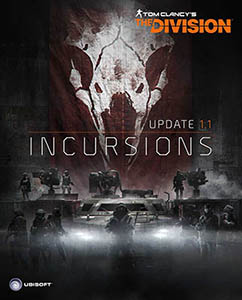
Incursions
In April, the first free update will introduce a new challenging end-game activity developed specifically for squad play. Teams of up to four players will be able to test their skills as they face seemingly unstoppable enemies to gain high-level weapons and equipment.
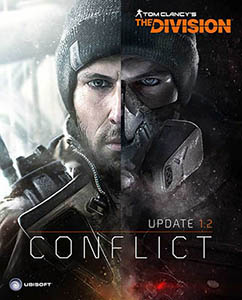
Conflict
In May, the second free update will add new features to the Dark Zone and add a new incursion in the iconic Columbus Circle
3 Expansions

Expansion I: Underground
Available in June, this first major expansion lets players explore the uncharted underworld of New York City. Players will chase deadly enemies with up to three other Agents through an endless maze of tunnels and subways.

Expansion II: Survival
Available this summer, this expansion will challenge players will have to survive as long as possible by gathering essential supplies and high-tech equipment to take back New York- if they don’t succumb to the temptation and turn Rogue.

Expansion III: Last Stand
Next winter, a new threat rises as players and their squad must prepare to defend against a relentless foe.
Editions
Sleeper Agent Edition(Collectors Edition)

Gold Edition
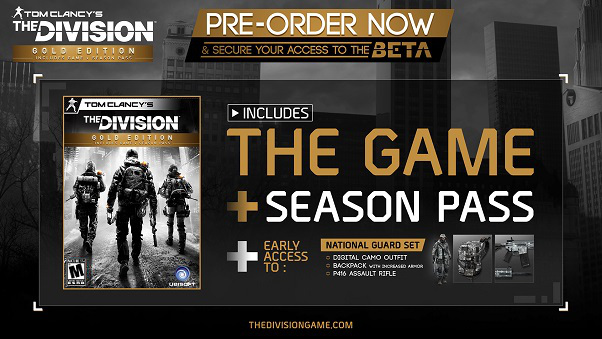
Gold Edition includes:
The game
Season Pass
Exclusive National Guard gear set
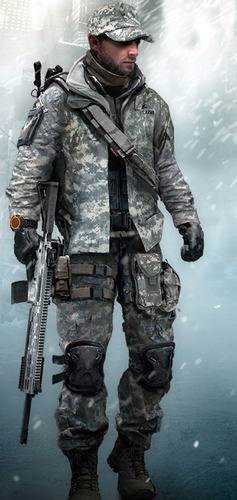

Day One Edition

The Division drops March 8th but what exactly is The Division
What is The Division?
It’s a lot of things, actually. It’s a third-person, cover-based shooter; it’s an RPG with loot; it’s a seamless multiplayer experience that encourages cooperative play, but lets you play solo, too. It’s a PvP-enabled game with an interesting twist that can put you in some morally questionable situations.
What do you do in the game?
One of your many goals is to make your own character stronger so that he or she can tackle more difficult situations. The Division’s character progression occurs through a couple of different paths.
The bulk of your experience outside of the Dark Zone comes from completing missions. In our play session, these came in two forms – smaller, skirmish-like events that spring up as you explore New York City, and missions that are tied to your Base of Operations.
What’s the Base of Operations?
One of the first things our squad does after grouping up in one of The Division’s safe zones social areas that let you interact with other agents, as well as buy gear and weapons – is make our way into the depths of city, towards the base. As we arrive, we find the Joint Task Force NPC soldiers outside, defending it against some rioters. After a brief firefight, we’re victorious. The JTF thanks us for helping them, and we make our way inside.
It’s here we discover that the base is in pretty bad shape, but there’s an opportunity to turn things around by finding the right people to get the base’s three wings – medical, security, and tech – up and running. Exploring the base opens up an initial set of missions that involve tracking these individuals down in different parts of the city, where they may be trapped by enemy forces.
Upgrading the wings represents more than just a physical manifestation of your progress in The Division. It also lets you produce new skills for your agent, as well as skill mods, talents, and perks. Purchasing the “clinic” upgrade grants the First Aid skill, which lets you heal yourself and other agents. Along with that comes a perk that extends the amount of med kits you can carry by one.
What’s the Dark Zone?
The Dark Zone is the PvP-enabled area populated with enemies and other players. The reason it’s PvP-enabled and not strictly labeled as a PvP zone is pretty simple: you ultimately make the choice whether to engage in PvP or not. As you probably have seen by now, most squads in the Dark Zone are there because they want to get some of the better loot in the game. At any given time, other players can either help them get that loot, or they can try to take it from them. Choosing the latter means that you’ve gone rogue, and will be designated as such to other agents – who are then free to kill you without going rogue themselves.
What are some of the story missions like?
Our squad played a couple of the main story missions, like the aforementioned rescue of Dr. Kandel to unlock the security wing. But we played some others, including one that has you fighting your way through a tunnel, only to be forced to go on the defensive and engage in a pretty large firefight against waves of enemies and a pesky (and very strong) sniper who you might call the “boss” of that particular mission. We also played a late-game mission that had our squad infiltrating an event center to take down an absolutely brutal gang leader. In every single one of those instances, communicating and using some kind of tactical strategy were immensely beneficial.
In fact, in the sniper mission, two of the three people in our squad ended up serving as a diversion to the sniper and most of the enemies, so that the other person could flank the sniper and take them out point-blank with several shotgun blasts. Previously, we’d just tried to brute-force our way up the middle, using the cars as cover, but it just didn’t work out well for us.

There are five different rarities of gear within The Division. These range from Common to Legendary. Each item is denoted by color text, quality, level required to equip, and a colored "orb" drop. When an item drops, you will see a small orb of one of the five colors.
As you approach an item and look at it, you will be presented with what the item is, what level is required to equip as well as if it has any mod slots. If you are in a Dark Zone and acquire a piece of gear, the stats of the item will not be revealed until you successfully extract the item by helicopter.
Mod slots allow you to manipulate a weapon to your specialty. Mod slots that have been revealed so far are scopes, suppressors, extended magazines, recoil pads, and foregrips. However there are many more that have not been revealed yet to the public.
Each item has a varying degree of mod slots from zero to four. These depend heavily on quality and type of item. Regular gear such as backpacks and chest pieces also have mod slots, however what those particular mod slots can hold has yet to be revealed to the public.
As you will see in the image above, some items will also have set affixes attached to them such as "Tactical". Currently, there are four categories of gear that we know of: Tactical, Riot, Expedition and Operative. Each give varying bonus' to not only your skill set but also your Armor Rating (AR).
You will also notice that some gear, such as the backpack, gives a bonus to skill damage as well as max ammo capacity. There are multiple set bonus' for gear. We dont know a total of how many there are currently however.
Contaminated Loot:
Contaminated loot is loot you acquire within the Dark Zone. When you acquire a piece of gear in the Dark Zone, you place it into your contaminated loot inventory which is denoted by a yellow biohazard container strapped to your back as denoted below. This is a double edged sword. Not only does it mean you picked up some sweet gear, but it also means that other people can see you have something worth looting as well.
Loot is personal, or instanced, within The Division such as games like Diablo III, which means that you and only you will see your own drops. However, if you are killed within the Dark Zone there is a possibility that you may drop a piece of gear that you have acquired. If you do happen to drop a piece of gear, all players within the vicinity will be able to see it which in turn makes it free game.
When you find a piece of contaminated loot, stats of the item will not be visible until you find an extraction zone and raise your flare for extraction. Your signal flare can be seen by all players within the field of view from it. In doing so, a timer begins, which is 90 seconds currently, in which you have to defend yourself if you are alone, or your team leader who initated the extraction before the helicopter reaches you.
Calling extraction while in a party basically creates a minigame of VIP / HVT. Enemy players only have to kill your team leader, or whoever initiated the extraction to cancel it. This is where teamwork becomes crucial and betrayal a viable option.
Once the helicopter reaches you, you take your contaminated loot container and strap it to a rope dropped from the helicopter and attach it to a carbiner. You may extract 6 items per extraction with a maximum of 36 items total (as of the demo). If you successfully defend yourself, or your team you will see "Extraction Successful" across the screen. As of this point you may exit the Dark Zone on foot and find your items back at your Base of Operations.
In turn, you may also cancel another player or teams extraction by either forcing them out of bounds, killing them and their party, or letting them successfully extract. The choice is yours.
Rogue Protocol:
In the event that you wish to engage other players in the Dark Zone, or accidentally hit another player in cross fire, you will enter rogue status. Upon impact of friendly fire, your radio will sound of and say, "Rogue Protocol Initiated". Your Smart Watch and player indicator on your backpack will turn from orange (friendly) to red (hostile). A timer will show over your right shoulder counting down. This is a count down from hostile to friendly status again.
In the event that you actually kill someone, the timer will turn into a skull with a ring around it. This labels you as a Rogue agent. Each agent you kill will raise the timer to a maximum of 300 seconds with another segment of the circle filling up. Consider this like a Wanted Level in Grand Theft Auto. If your Rogue status level is continuously five segments, there will be consequences inside and outside of the Dark Zone. One consequence in the Dark Zone is that everyone will be able to see where you are. Outside of the Dark Zone hasnt been revealed yet, however I would expect it to be similar to other MMOs where NPCs wont sell you items or even talk to you, though at this point that is purely speculation.
Loadout:
From top to bottom:
-Contaminated Inventory - Anything you pick up within the Dark Zone will be placed here until it is successfully extracted.
-Primary - Your current primary weapon.
-Secondary - Your current secondary weapon.
-Sidearm - Your current sidearm weapon.
-Backpack - There are multiple different backpacks, each with their own bonus'.
-Body Armor
-Gloves
-Thighs
-Kneepads
-Face/Head - These range from things such as respirators, hats, beanies, balaclavas, ect.
Skills:
The Division runs on a classless system which means that you can respec your character at any time. As ive said in my hands on impressions article, you may loot a piece of gear in or outside of the Dark Zone that you feel doesnt benefit you at the time, however it's good to hang on to in case the need arises that you have to change your class based upon the challenge presented.
Skills are accessed by a skill tree, each having upgrades and variations. For instance the sentry turret can be toggled between a turret that shoots ammunition or more of a deterrent that uses a flamethrower which brings up another point of interest, there is elemental damage in The Division as with any other RPG.
Click to expand...

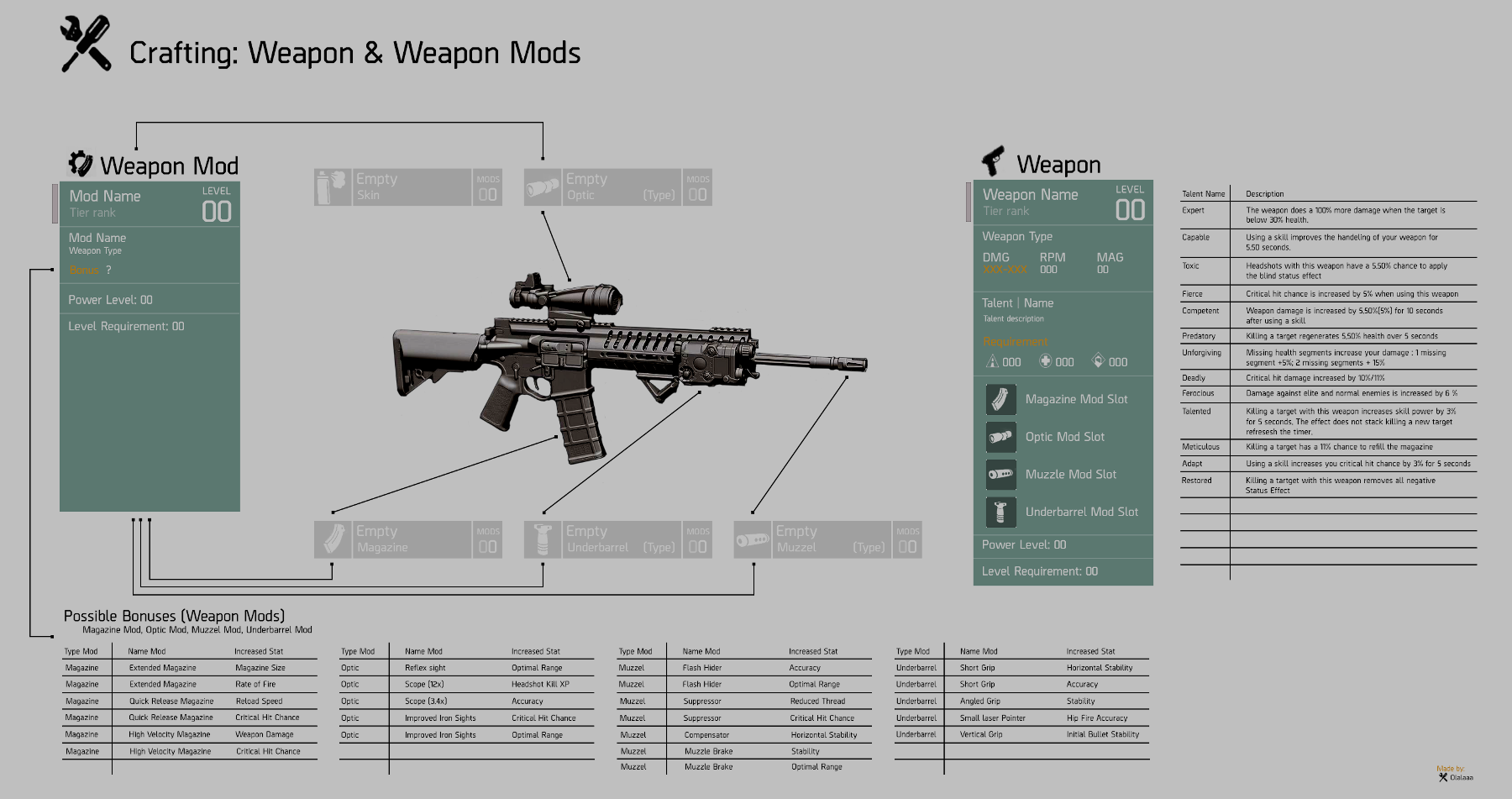
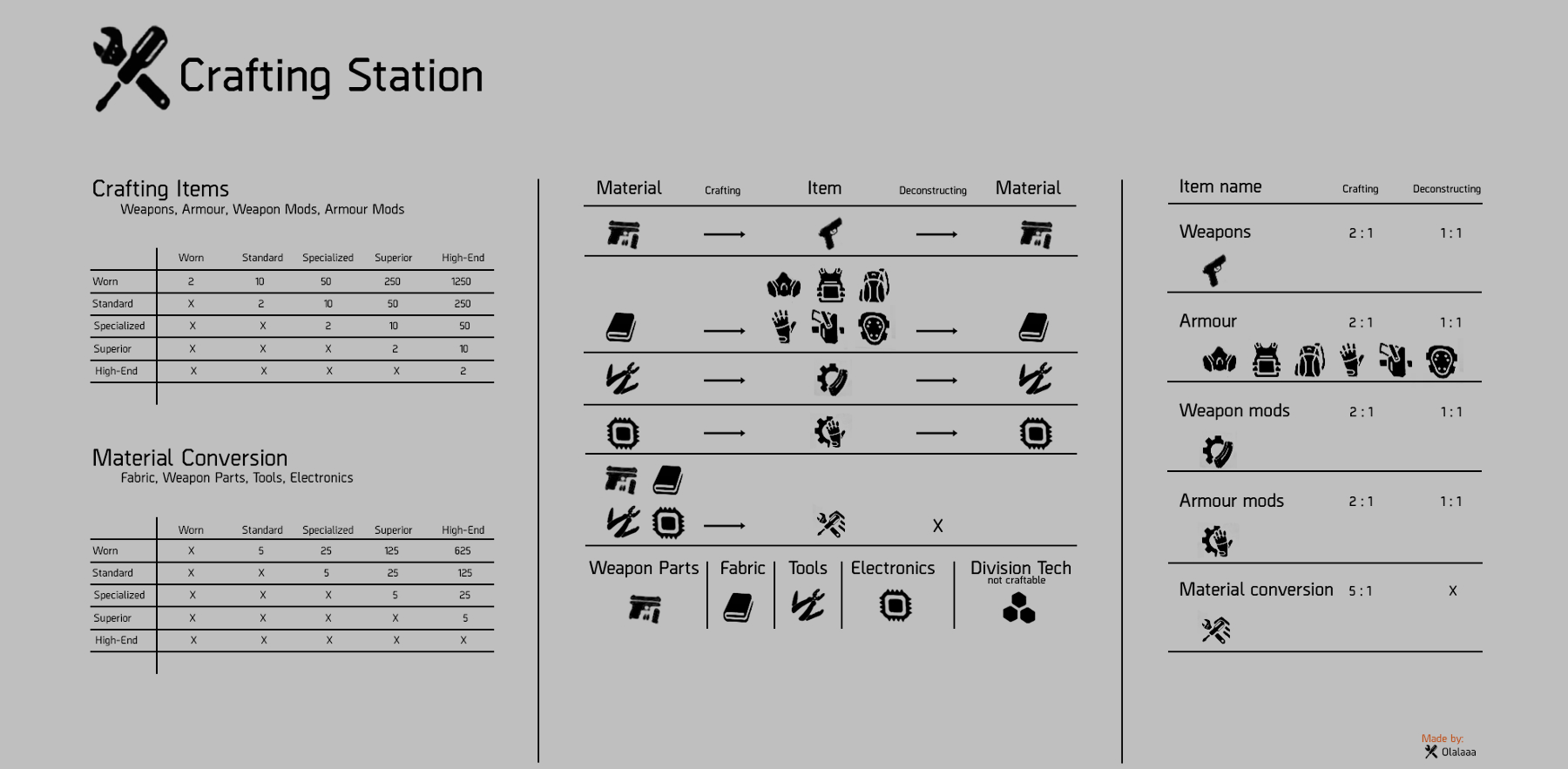
Enemy Factions
Skills
PRE ORDER BONUS
HAZMAT GEAR SET

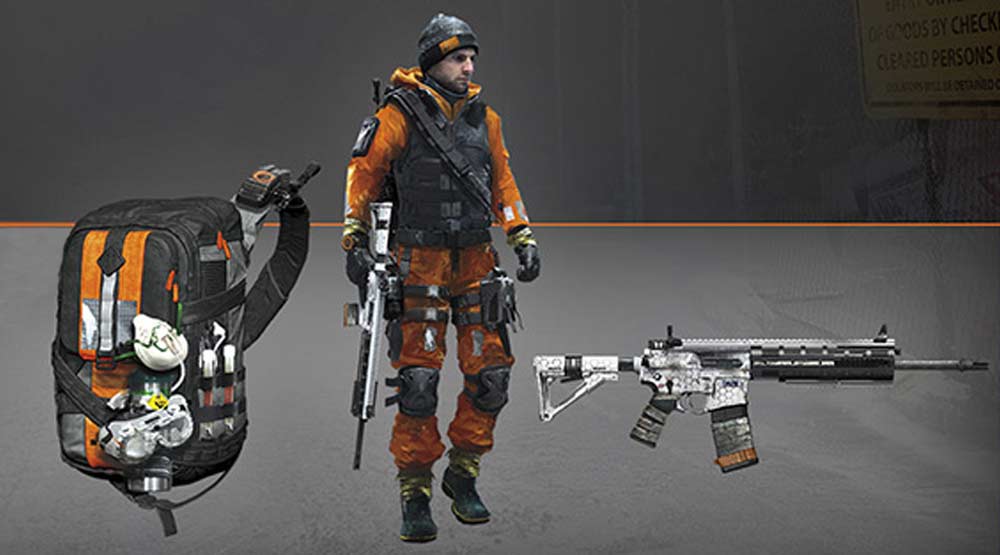
Rainbow Six Siege Owners Bonus
TACTICAL GEAR SET

Four Free Gear Sets
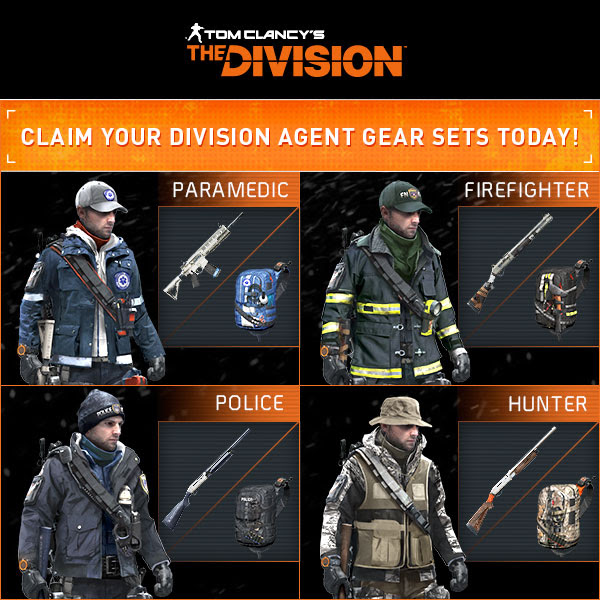
Follow this Link The Division Agent Origins | Ubisoft (US)
Enter AGENTORGINS
SEASON PASS
Season Pass Breakdown
YEAR ONE ROADMAP

Following launch, you will be able to take on new tasks and challenges within the main storyline and end-game through daily and weekly missions as well as Dark Zone events.
In addition to these ongoing activities, 2 free updates and 3 paid expansions will also be released over the course of the year.
2 FREE UPDATES

Incursions
In April, the first free update will introduce a new challenging end-game activity developed specifically for squad play. Teams of up to four players will be able to test their skills as they face seemingly unstoppable enemies to gain high-level weapons and equipment.

Conflict
In May, the second free update will add new features to the Dark Zone and add a new incursion in the iconic Columbus Circle
3 Expansions

Expansion I: Underground
Available in June, this first major expansion lets players explore the uncharted underworld of New York City. Players will chase deadly enemies with up to three other Agents through an endless maze of tunnels and subways.

Expansion II: Survival
Available this summer, this expansion will challenge players will have to survive as long as possible by gathering essential supplies and high-tech equipment to take back New York- if they don’t succumb to the temptation and turn Rogue.

Expansion III: Last Stand
Next winter, a new threat rises as players and their squad must prepare to defend against a relentless foe.
Editions
Sleeper Agent Edition(Collectors Edition)

- Tom Clancy's The Division Collector's Edition Includes:
- Tom Clancy's The Division Game
- Season Pass
- Real Agent Watch
- Poster
- Agent Armband
- Art Book
Gold Edition

Gold Edition includes:
The game
Season Pass
Exclusive National Guard gear set


Day One Edition

The Division drops March 8th but what exactly is The Division
What is The Division?
It’s a lot of things, actually. It’s a third-person, cover-based shooter; it’s an RPG with loot; it’s a seamless multiplayer experience that encourages cooperative play, but lets you play solo, too. It’s a PvP-enabled game with an interesting twist that can put you in some morally questionable situations.
What do you do in the game?
One of your many goals is to make your own character stronger so that he or she can tackle more difficult situations. The Division’s character progression occurs through a couple of different paths.
The bulk of your experience outside of the Dark Zone comes from completing missions. In our play session, these came in two forms – smaller, skirmish-like events that spring up as you explore New York City, and missions that are tied to your Base of Operations.
What’s the Base of Operations?
One of the first things our squad does after grouping up in one of The Division’s safe zones social areas that let you interact with other agents, as well as buy gear and weapons – is make our way into the depths of city, towards the base. As we arrive, we find the Joint Task Force NPC soldiers outside, defending it against some rioters. After a brief firefight, we’re victorious. The JTF thanks us for helping them, and we make our way inside.
It’s here we discover that the base is in pretty bad shape, but there’s an opportunity to turn things around by finding the right people to get the base’s three wings – medical, security, and tech – up and running. Exploring the base opens up an initial set of missions that involve tracking these individuals down in different parts of the city, where they may be trapped by enemy forces.
Upgrading the wings represents more than just a physical manifestation of your progress in The Division. It also lets you produce new skills for your agent, as well as skill mods, talents, and perks. Purchasing the “clinic” upgrade grants the First Aid skill, which lets you heal yourself and other agents. Along with that comes a perk that extends the amount of med kits you can carry by one.
What’s the Dark Zone?
The Dark Zone is the PvP-enabled area populated with enemies and other players. The reason it’s PvP-enabled and not strictly labeled as a PvP zone is pretty simple: you ultimately make the choice whether to engage in PvP or not. As you probably have seen by now, most squads in the Dark Zone are there because they want to get some of the better loot in the game. At any given time, other players can either help them get that loot, or they can try to take it from them. Choosing the latter means that you’ve gone rogue, and will be designated as such to other agents – who are then free to kill you without going rogue themselves.
What are some of the story missions like?
Our squad played a couple of the main story missions, like the aforementioned rescue of Dr. Kandel to unlock the security wing. But we played some others, including one that has you fighting your way through a tunnel, only to be forced to go on the defensive and engage in a pretty large firefight against waves of enemies and a pesky (and very strong) sniper who you might call the “boss” of that particular mission. We also played a late-game mission that had our squad infiltrating an event center to take down an absolutely brutal gang leader. In every single one of those instances, communicating and using some kind of tactical strategy were immensely beneficial.
In fact, in the sniper mission, two of the three people in our squad ended up serving as a diversion to the sniper and most of the enemies, so that the other person could flank the sniper and take them out point-blank with several shotgun blasts. Previously, we’d just tried to brute-force our way up the middle, using the cars as cover, but it just didn’t work out well for us.

There are five different rarities of gear within The Division. These range from Common to Legendary. Each item is denoted by color text, quality, level required to equip, and a colored "orb" drop. When an item drops, you will see a small orb of one of the five colors.
As you approach an item and look at it, you will be presented with what the item is, what level is required to equip as well as if it has any mod slots. If you are in a Dark Zone and acquire a piece of gear, the stats of the item will not be revealed until you successfully extract the item by helicopter.
Mod slots allow you to manipulate a weapon to your specialty. Mod slots that have been revealed so far are scopes, suppressors, extended magazines, recoil pads, and foregrips. However there are many more that have not been revealed yet to the public.
Each item has a varying degree of mod slots from zero to four. These depend heavily on quality and type of item. Regular gear such as backpacks and chest pieces also have mod slots, however what those particular mod slots can hold has yet to be revealed to the public.
As you will see in the image above, some items will also have set affixes attached to them such as "Tactical". Currently, there are four categories of gear that we know of: Tactical, Riot, Expedition and Operative. Each give varying bonus' to not only your skill set but also your Armor Rating (AR).
You will also notice that some gear, such as the backpack, gives a bonus to skill damage as well as max ammo capacity. There are multiple set bonus' for gear. We dont know a total of how many there are currently however.
Contaminated Loot:
Contaminated loot is loot you acquire within the Dark Zone. When you acquire a piece of gear in the Dark Zone, you place it into your contaminated loot inventory which is denoted by a yellow biohazard container strapped to your back as denoted below. This is a double edged sword. Not only does it mean you picked up some sweet gear, but it also means that other people can see you have something worth looting as well.
Loot is personal, or instanced, within The Division such as games like Diablo III, which means that you and only you will see your own drops. However, if you are killed within the Dark Zone there is a possibility that you may drop a piece of gear that you have acquired. If you do happen to drop a piece of gear, all players within the vicinity will be able to see it which in turn makes it free game.
When you find a piece of contaminated loot, stats of the item will not be visible until you find an extraction zone and raise your flare for extraction. Your signal flare can be seen by all players within the field of view from it. In doing so, a timer begins, which is 90 seconds currently, in which you have to defend yourself if you are alone, or your team leader who initated the extraction before the helicopter reaches you.
Calling extraction while in a party basically creates a minigame of VIP / HVT. Enemy players only have to kill your team leader, or whoever initiated the extraction to cancel it. This is where teamwork becomes crucial and betrayal a viable option.
Once the helicopter reaches you, you take your contaminated loot container and strap it to a rope dropped from the helicopter and attach it to a carbiner. You may extract 6 items per extraction with a maximum of 36 items total (as of the demo). If you successfully defend yourself, or your team you will see "Extraction Successful" across the screen. As of this point you may exit the Dark Zone on foot and find your items back at your Base of Operations.
In turn, you may also cancel another player or teams extraction by either forcing them out of bounds, killing them and their party, or letting them successfully extract. The choice is yours.
Rogue Protocol:
In the event that you wish to engage other players in the Dark Zone, or accidentally hit another player in cross fire, you will enter rogue status. Upon impact of friendly fire, your radio will sound of and say, "Rogue Protocol Initiated". Your Smart Watch and player indicator on your backpack will turn from orange (friendly) to red (hostile). A timer will show over your right shoulder counting down. This is a count down from hostile to friendly status again.
In the event that you actually kill someone, the timer will turn into a skull with a ring around it. This labels you as a Rogue agent. Each agent you kill will raise the timer to a maximum of 300 seconds with another segment of the circle filling up. Consider this like a Wanted Level in Grand Theft Auto. If your Rogue status level is continuously five segments, there will be consequences inside and outside of the Dark Zone. One consequence in the Dark Zone is that everyone will be able to see where you are. Outside of the Dark Zone hasnt been revealed yet, however I would expect it to be similar to other MMOs where NPCs wont sell you items or even talk to you, though at this point that is purely speculation.
Loadout:
From top to bottom:
-Contaminated Inventory - Anything you pick up within the Dark Zone will be placed here until it is successfully extracted.
-Primary - Your current primary weapon.
-Secondary - Your current secondary weapon.
-Sidearm - Your current sidearm weapon.
-Backpack - There are multiple different backpacks, each with their own bonus'.
-Body Armor
-Gloves
-Thighs
-Kneepads
-Face/Head - These range from things such as respirators, hats, beanies, balaclavas, ect.
Skills:
The Division runs on a classless system which means that you can respec your character at any time. As ive said in my hands on impressions article, you may loot a piece of gear in or outside of the Dark Zone that you feel doesnt benefit you at the time, however it's good to hang on to in case the need arises that you have to change your class based upon the challenge presented.
Skills are accessed by a skill tree, each having upgrades and variations. For instance the sentry turret can be toggled between a turret that shoots ammunition or more of a deterrent that uses a flamethrower which brings up another point of interest, there is elemental damage in The Division as with any other RPG.



Enemy Factions
Skills
PRE ORDER BONUS
HAZMAT GEAR SET


Rainbow Six Siege Owners Bonus
TACTICAL GEAR SET

Four Free Gear Sets

Follow this Link The Division Agent Origins | Ubisoft (US)
Enter AGENTORGINS





 will cop, but what system?
will cop, but what system?